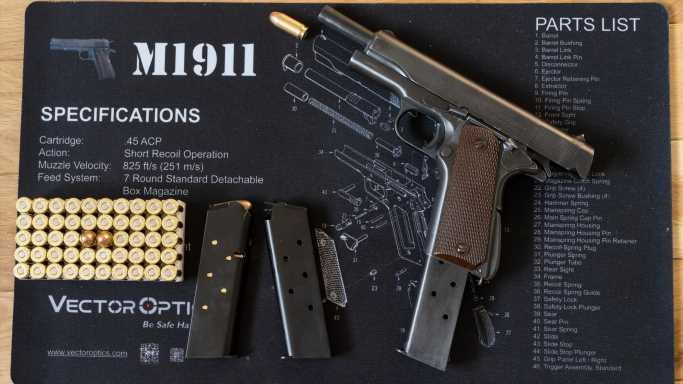Sidearms, or service pistols, are typically a weapon of last resort in the U.S. military. Less accurate than a rifle or carbine at long range, and less lethal than shotgun at close range, handguns are still a practical self-defense weapon, and can be life saving in combat situations. While not typically carried by enlisted service members, sidearms are widely carried by special forces operators and higher ranking officers.
Since the Revolutionary War, the American military has issued a variety of sidearms. These guns were chosen for their reliability, durability, and lethality. Most recently, in January 2017, the U.S. Army announced plans to switch to a new standard issue pistol – the Sig Sauer M17 and M18, based on the company’s P320 pistol. The decision marked the end of over 30 years of service for the Beretta M9 pistol, and is only the latest in a long series of upgrades in the last two and a half centuries. (Here is a look at 17 prototype guns rejected by the U.S. military.)
Using data from the Army report Survey of U.S. Army: Uniforms, Weapons, and Accoutrements, 24/7 Wall St. identified the sidearms used by the U.S. Army since the 18th century. For earlier weapons, we listed the era in which they were primarily used, but for more modern handguns, the exact years of use are noted. This list includes flintlock pistols from the earliest days of American independence, to modern day semi-automatics.
A historical look at U.S. Army sidearms is a direct reflection of the evolution of firearm technology. Flintlock pistols of the late 18th and early 19th centuries were eventually replaced by percussion cap firearms, which ignited gun powder with an explosive chemical compound rather than a piece of flint striking steel. These guns were easier to load, more reliable, and more weather resistant than the flintlock design.
From the mid 19th century through the early 20th century, revolvers were the standard issue military pistol. Loaded with self contained cartridges and capable of firing multiple rounds before being reloaded, revolvers marked a significant upgrade from percussion cap guns.
But since World War II, the U.S. Army has relied almost exclusively on semi-automatic pistols, which offer greater magazine capacity and faster reload times than revolvers. Semi-automatics also easier to functionally maintain in muddy conditions than revolvers. In service for multiple decades before being replaced by the Beretta M9, the Colt 1911 semi-automatic pistol was used by the U.S. military in nearly every conflict the U.S. was involved in during the 20th century – from World War I through Vietnam. (Here is a look at America’s top pistol companies.)
Click here to see every standard issue US Army sidearm since the American Revolution.
Sponsored: Find a Qualified Financial Advisor
Finding a qualified financial advisor doesn’t have to be hard. SmartAsset’s free tool matches you with up to 3 fiduciary financial advisors in your area in 5 minutes. Each advisor has been vetted by SmartAsset and is held to a fiduciary standard to act in your best interests. If you’re ready to be matched with local advisors that can help you achieve your financial goals, get started now.
Source: Read Full Article
-
Mutual funds buy the dip in IT stocks; invest Rs 9,500 crore in 2023
-
YouTube Won’t Remove Videos Claiming 2020 Election Was Stolen, But RFK Jr. Claims Instagram Ban For Campaign Site
-
Commuters will take longer or more costly route to work to avoid germs
-
Bob Iger’s Return Engagement As Disney CEO Sees A Plot Twist In Abrupt Exit Of A Long-Tenured Lieutenant, CFO Christine McCarthy
-
Pvt life insurance stocks up on decent growth prospects in Q1

